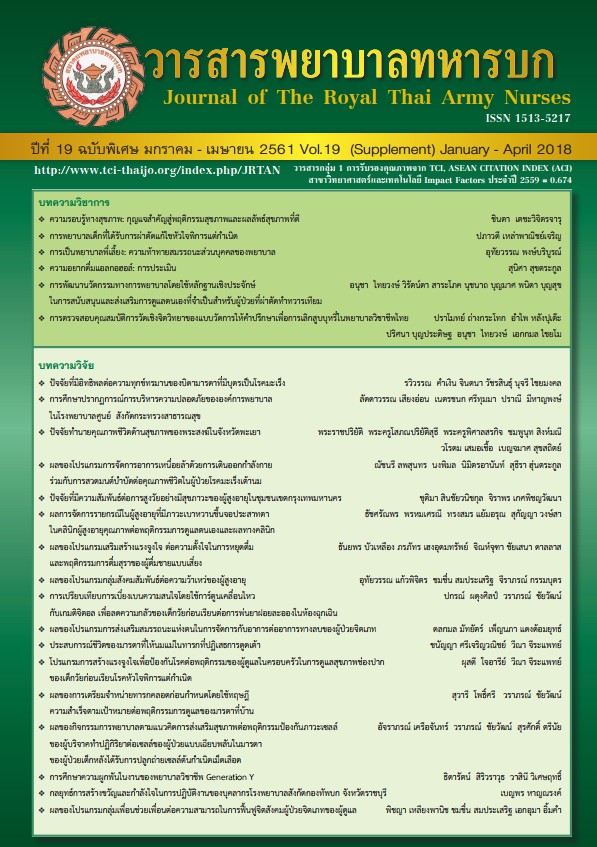The Questionnaire Development for the Strategic Leadership Components of Prosthetic and Orthotic Practitioners in Thailand
Keywords:
Components of Strategic Leadership, Prosthetic and Orthotic PractitionersAbstract
Qualitative research method was used in this study. The objective of this study was to develop a questionnaire for Strategic Leadership of Prosthetic and Orthotic Practitioners in Thailand. The methods of study were to synthesize concepts, theories, related research, focus group discussion and in-depth interview. Informants were administrators as well as prosthetic and orthotic practitioners who have been working in medical institutes, secondary-level and tertiary-level hospital. Twenty informants were purposely selected for focus group discussion and 8 informants were selected for in-depth interview. Content validity was measured by using Index of Item-Objective Congruence (IOC) and Content Validity Index (CVI). Reliability was measured by using Cronbach alpha coefficient The synthesis of research results revealed that there were 7 components of strategic leadership of prosthetic and orthotic practitioners in Thailand including; (1) Strategic thinking and planning; 14 items, (2) Developing today’s and tomorrow’s leader; 10 items (3) Relating the part to the whole; 15 items, (4) Making it happen; 7 items, (5) Releasing corporate spirit; 6 items, (6) Giving direction; 7 items, and (7) Building partnership; 6 items. Totally, there were 65 items. As a questionnaire was developed based on those components, it was brought to test content validity. The results showed that the value of IOC for each item was .96 as well as the value of CVI = 0.81. Reliability of the questionnaire was tested by using Cronbach alpha coefficient and it was found that α = 0.98. From the research findings, it be suggested that the questionnaire should be taken further to confirm with the empirical data.
References
2. Yawiraj N. Leadership and Strategic Leader. 6th Edition. Bangkok: Central express. 2007. (in Thai)
3. Sripakho P. Professional Nursing Development: Developing Nursing Leadership. Journal of The Royal Thai Army Nurses. 2014; 15(3): 1-8. (in Thai)
4. Jumnonglert T. Relationship between Strategic Leadership of Head Nurses Organization Climate and Effectiveness of Patient Units as Perceived by Professional Nurses at Governmental University Hospitals. A thesis for Master Degree of Nursing Science Program in Nursing Administration. Bangkok:
Chulalongkorn University. 2007. (in Thai)
5. Nongthanathorn Phiphat. Strategic Leadership and Organization Effectiveness: A study of the mass rapid transit authority of Thailand. A Dissertation submitted in partial fulfillment of the requirement for the degree of philosophy national Institute of Development Administration. 2002.
6. DuBrin, A.J. Leadership Research Finding, Practice, and Skills. 4th edition. New York: Houghton Miffin Company. 2004
7. Davies, B.J. and Devies, B.. Strategic Leadership. School of Leadership & Management. 2004; 23 (1): 29-38.
8. Daft. The Leadership Experience, 5th Edition. Thomson: South-Western. 2005
9. Lussier, N.R., and Achua, F.C. Effective Leadership. 3rd edition. Ohio: Thompson South-Western. 2007
10. Schermerthorn, J. R. Management. 9th edition. New York: John Wiley & Sons. 2008
11. Dess, G.G., Lumpkin, T.G., and Eisner A.B. Management. 2nd edition. New York: McGraw-Hill. 2008
12. Klaewplodtook S. Relationship between Strategic Leadership of Head Nurses, Performance Management of Nursing Division, and Effectiveness of Patients Units as Perceived by Staff Nurses, General Hospitals. A thesis for Master Degree of Nursing Science Program in Nursing Administration. Bangkok: Chulalongkorn University. 2008. (in Thai)
13. Duangkeaw T. Relationship between Strategic Leadership of Head Nurses, Job Involvement of Staff Nurses, and Effectiveness of Patients Units, General Hospitals Under Jurisdiction of the Ministry of Public Health in Northern Region. A thesis for Master Degree of Nursing Science Program in Nursing Administration.
Bangkok: Chulalongkorn University. 2009. (in Thai)
14. Wongkhomthong J, Srithumma N, Jintanadilok N. The Competencies of Strategic Leadership of Chief Nurse Executives Private Hospital in Bangkok Metropolitan. Christian University Journal. 2014; Volume 20(2) : 353-359. (in Thai)
15. Jitsanguan K. A model of strategic leadership development for secondary school administrators. Eastern Asia University Heritage Journal Social
Science and Humanity. 2014; Volume 4(1): 201-211. (in Thai)
1 6. Janthapoon P. and Sumettikul P. Development of Collaborative Network Management Strategies for Small Sized School Development. Journal
of education studies, Chulalongkorn University. 2014; Volume 42(1): 81-94. (in Thai)
17. Wajanawongpanya P, Wisetsiri P, and Sinlarat P. Strategies for the Development of Thai-Style Leaders’ Characteristics of Administrators in Basic Education Institution. Eastern Asia University Heritage Journal Social Science and Humanity.2014; Volume 3(2): 208-221. (in Thai)
18. Adair,.J. Strategic Leadership: How to think and plan strategically and provide direction. London: Kogan Page; 2010.
19. Opartkiattikul N. A decade of Sirindhorn School of Prosthetics and Orthotics (2002-1012). 1st ed. Bangkok: P.A. Living co.L.Td; 2012.
(in Thai)
20. Thailand Nursing and Midwifery Council. Professional Act of Nursing and Midwifery. 2nd edition. Bangkok. 1997. (in Thai)
Downloads
Published
How to Cite
Issue
Section
License
บทความหรือข้อคิดเห็นใดใดที่ปรากฏในวารสารพยาบาลทหารบกเป็นวรรณกรรมของผู้เขียน ซึ่งบรรณาธิการหรือสมาคมพยาบาลทหารบก ไม่จำเป็นต้องเห็นด้วย
บทความที่ได้รับการตีพิมพ์เป็นลิขสิทธิ์ของวารสารพยาบาลทหารบก
The ideas and opinions expressed in the Journal of The Royal Thai Army Nurses are those of the authors and not necessarily those
of the editor or Royal Thai Army Nurses Association.





